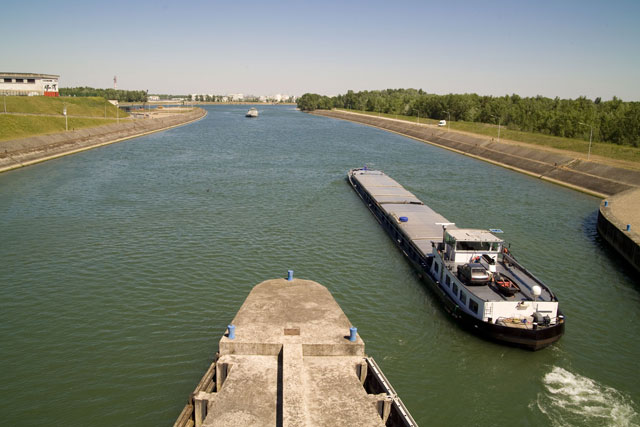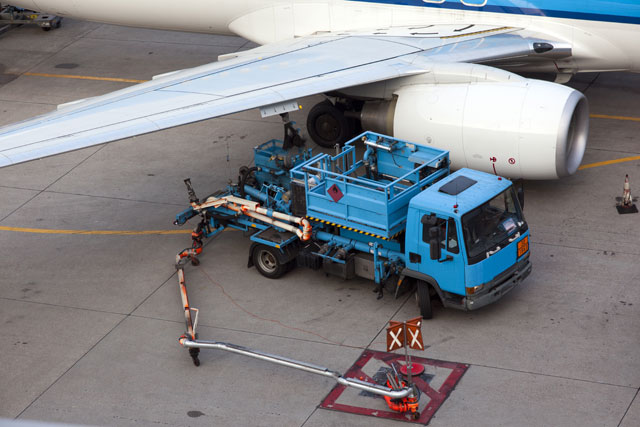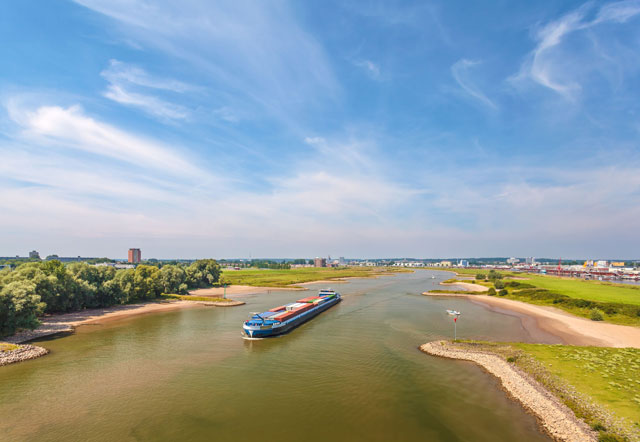Transport
Goods and persons transported via water, road, air, and railways.
Transport represents almost a quarter of Europe's greenhouse gas emissions and is the main cause of air pollution in cities. Road transport contributes about one-fifth of the EU's total emissions of carbon dioxide (CO2), the main greenhouse gas causing climate change (EC 2017a). While these emissions fell by 3.3% in 2012, they are still 20.5% higher than in 1990. Direct emissions from aviation account for about 3% of the EU’s total greenhouse gas emissions and more than 2% of global emissions (EC 2017b). Transport is the only major sector in the EU where greenhouse gas emissions are still rising.
Inland waterways and coastal shipping are an important aspect of the transportation of goods in Europe. Nearly 90% of the EU’s external trade, and more than 40% of its internal trade goes by sea, and more than 200 EU coastal ports handle nearly 2 billion tonnes of freight every year (EEA 2012). The transportation of goods and navigation infrastructure works can create widespread hydromorphological pressures. Large container ships and ferries require deep and open waterways and harbour areas, so waterways, ports and harbours rely on dredging, water level management, channelisation, straightening, bank reinforcement and fixation for safe navigational access.
Inland navigation is often seen as a form of freight transport with lower greenhouse gas emissions in comparison to road and rail transport, which has led to the promotion of future developments of large rivers for inland navigation e.g. NAIADES, Trans-European Transport Network (TEN-T) policy (EC 2012, EEA 2012b). Such environmental conflicts illustrate the challenges of balancing different interacting drivers and pressures on European freshwaters (EEA 2012b).
Water is used in large volumes in the production of energy by a range of means, most notably thermal generation (which includes nuclear and the burning of fossil fuels) and hydropower. Currently, thermal generation provides around 75% of European electricity, and hydropower a further 17%, meaning freshwater use is intrinsic in European power generation (van Vliet et al. 2013). The growth in popularity of shale gas extraction, steam injection, hydraulic fracturing, and horizontal drilling – all of which require high inputs of water – means that the water use per mega joule of energy produced in Europe is likely to increase into the future (EEA 2012a). Water quantity and health may also impacted by renewable energy production, particularly hydropower and bio-energy cultivation (through the irrigation of biofuels crops).
Hydropower has been recognised as one of the main drivers in the changing hydromorphology of European rivers, reducing ecological connectivity, altering flows of water, species, nutrients and sediment (EEA 2012b). However, as a renewable energy source, the number of hydropower plants (and their associated reservoirs, dams and weirs) is likely to increase over the coming decades in the face of climate change, and government attempts to limit our dependence on fossil fuels. It is therefore important that the potential negative impacts of hydropower production for aquatic ecosystems are taken into account in planning.
Transportation pressures
Physical alteration of channel/bed/riparian area/shore of water body: Watercourses often have to be deepened, widened or reinforced for transportation uses. The dredging of inland transportation waterbodies is common to create navigable courses and harbours, which can have significant impacts on morphology and ecological status, as well as the quantity, quality and velocity of water flows. Transportation also leads to physical forces such as waves and water displacement from passing ships, causing shoreline erosion and making exposed shoreline habitats unsuitable for both plants and aquatic fauna.
Dams, barriers and locks: The usage of cross-profile constructions such as locks to contain water flows for navigation can have negative impacts on river flows and the movement of species, especially migratory fish, and lead to the fragmentation of ecological flows of species, water, nutrients and sediments.
Introduced species and diseases: The accidental introduction of invasive species, either via vessels (such as through ballast water) or through the introduction or expansion of aquatic transportation networks i.e. canals interconnecting river basin.
Point source and diffuse pollution:
Diffuse emissions resulting from road traffic sources – these sources include tyre wear, brake wear and engine oil leaks and cause emissions of heavy metals and polycyclic aromatic hydrocarbons (PAHs). Diffuse pollutants may enter nearby surface waters (e.g. urban rivers) or sewer systems (Deltares 2013).
Diffuse emissions of rubber particle dust – from tyre wear may be a major source of microparticle (mainly <80 micrometre) contamination. Part of the dust flies as particulate matter into the air, the rest lands directly on the road or adjoining land and from there a proportion will enter surface waters or drains (GESAMP 2016).
Pollutants from inland navigation – transportation activities can also lead to pollution, through oil spills, nutrients (domestic wastewater), polycyclic aromatic hydrocarbons (PAH, e.g. Fluoranthene) and heavy metals (e.g. copper from antifouling) (Deltares 2013).
Pollutants from railways - including PAH (from preserved wood used for railway sleepers) and copper (from pantographs and overhead wires).
CO2 emissions – road, railway, aviation and inland navigation networks which are powered by fossil fuels create significant emissions of carbon dioxide into the atmosphere, which scientific consensus states is driving ongoing changes to the Earth’s climate.
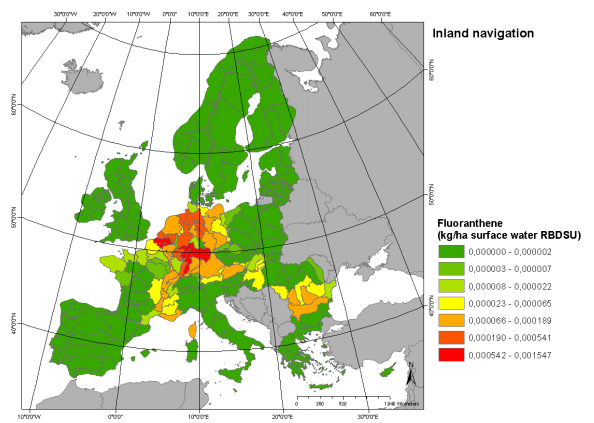
Fluoranthene from inland navigation per river basin district in Europe 2010 (Deltares 2013)
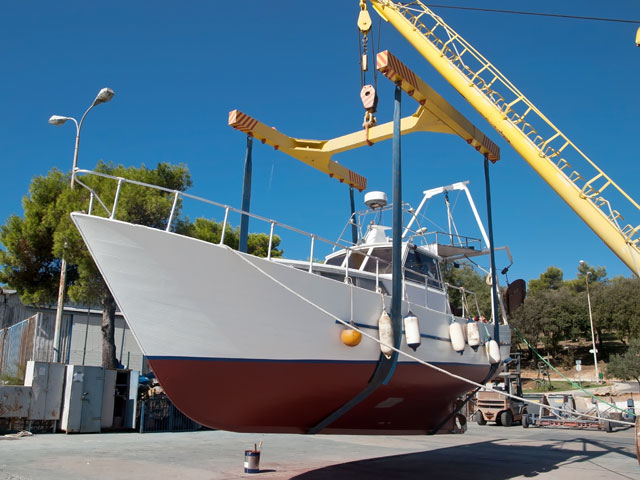
Anti-fouling substances to preserve boats lead to pollution
Geographical distributions and trends
The trans-European transport network (TEN-T) includes 138072 km of railway lines, 136706 km of roads, 23506 km of inland waterways across the 28 EU Member States. Major roads and freight and passenger railways cross the continent, with high speed routes most common in Central and Western Europe (TEN-T 2017). In 2014, passenger cars accounted for 72.3 % of public transport in the EU, powered two-wheelers for 1.9%, buses & coaches for 8%, railways for 6.5% and tram and metro for 1.5%; intra-EU air and intra-EU maritime transport contributed for 9.2% and 0.6% respectively (EC 2016). In 2015, the total number of passengers travelling by air in the European Union was 918 million, an increase of 4.7% compared to 2014, a growth trend which is projected to continue in the future (EUROSTAT 2016).
Use of passenger and freight transport is projected to continue to grow in Europe to 2030, driven by economic growth (EC 2013). Air transport is projected to be the highest growing of all passenger transport modes, increasing by 133% between 2010 and 2050 (2.1% p.a.); passenger rail activity is projected to increase by 79% between 2010-2050 (1.5% p.a.); total freight transport is projected to increase by about 57% (1.1% p.a.) between 2010 and 2050 (EC 2013). The EU Transport 2050 strategy seeks to dramatically reduce Europe's dependence on imported oil and cut carbon emissions in transport by 60% by 2050 through low-carbon transport networks, and which encourages shifts from road transport to rail and water transport (EC 2011).
Over 12,000 interconnected kilometres of the network of navigable inland waterways is accessible to vessels over 1000 ton, and includes some 450 locks and several hundred inland ports and transshipment sites. There are four main waterway transportation corridors in the EU: The Rhine Corridor, The Danube Corridor, The East-West Corridor and the North-South Corridor (EC 2012).
The Rhine Corridor comprises the entire Rhine confluence and the canals in the western part of Germany, Belgium, the Netherlands and Luxembourg and the eastern part of France and Switzerland.
The Danube (or South East) Corridor comprises the entire Danube confluence between German Bavaria and the Black Sea, as well as all tributaries and navigable canals such as the Main-Danube Canal.
The East-West Corridor comprises the Mittelland Canal in northern Germany and the confluences of Elbe, Oder and Vistula.
The North-South Corridor covers the major French rivers (Seine, Loire, Garonne, Rhone-Soane), and the navigable tributaries and linking canals extending between the lower Rhine area and the Mediterranean.
Almost all EU commercial goods transportation along inland waterways concerns just five countries: the Netherlands, Germany, France, Belgium and Romania. Of these, Germany and the Netherlands account for over three-quarters of the market, mostly as a result of the Rhine corridor, which is the most popular European waterway transportation route (EC 2012).
For example, fluoranthene emissions from inland navigation are high in the River Basins where 95% of the inland shipping takes place.
Potential for 'water friendly' mitigation
The European Commission produced new guidelines on ways to integrate nature protection into inland navigation strategy in 2012 (EC 2012). These detail the potential of ecologically-oriented river engineering for improving the ecology and natural functioning of European rivers used for inland navigation. Such management strategies are now being adopted for many rivers across Europe, notably in Austria, Belgium, Netherlands, France, Denmark and Germany.
The EC measures include the design of more natural river embankment design, the modification of groynes, bank protection structures e.g. parallel training walls, the smart use of floodplains to lower flow velocities and reduce erosion, the reconnection of floodplains to rivers and the rehabilitation of riparian zones, the creation of bypasses to allow the passage of fish and the adoption of ecologically orientated maintenance dredging and sediment management techniques.
In some areas, a part of the runoff water coming from highways and rural roads is collected and sometimes treated in a simple way (e.g. retention ponds) (Deltares 2013).
To help drivers choose new cars with low fuel consumption, EU legislation requires Member States to ensure that relevant information is provided to consumers, including a label showing a car's fuel efficiency and CO2 emissions.Fuel quality is an important element in reducing greenhouse gas emissions from transport. EU legislation requires the greenhouse gas intensity of vehicle fuels to be cut by up to 10% by 2020.
Further reading
Reports and publications:
Deltares (2013). Diffuse water emissions in E-PRTR (Download article, 1mb)
EC (2011). White Paper 2011 - Roadmap to a Single European Transport Area (Download article, 134kb)
EC (2012). Guidance document on Inland waterway transport and Natura 2000 (Download article, 3.7mb)
EC (2013). EU energy, transport and GHG emissions trends to 2050 (Download article, 3.5mb)
EC (2016). Statistical pocketbook - EU transport in figures (Download article, 2mb)
EEA (2012a). European waters - assessment of status and pressures (Download report, 28mb)
EEA (2012b). European waters - assessment of status and pressures - synthesis (Download report, 6.7mb)
GESAMP (2016). Sources, fate and effects of microplastics in the marine environment: part two of a global assessment, (Kershaw, P.J., and Rochman, C.M., eds). (IMO/FAO/UNESCO-IOC/UNIDO/WMO/IAEA/UN/ UNEP/UNDP Joint Group of Experts on the Scientific Aspects of Marine Environmental Protection). Rep. Stud. GESAMP No. 93, 220 p. (Download report, 6.5mb)
Söhngen B., Koop J., Knight S., Rythönen J., Beckwith P., Ferrari N., Iribarren J., Keevin T., Wolter C. & S. Maynord (2008). Considerations to reduce environmental impacts of vessels, report n°9. PIANC, Brussels (Read abstract)
Selected Freshwater blogs:
Freshwaterblog (2014). Chemical pollution threatens Europe’s freshwaters (External website)
Other websites:
EC (2017a). Road transport: Reducing CO2 emissions from vehicles (External website)
EC (2017b). Reducing emissions from aviation (External website)
TEN-T (2017). The trans-European transport network (TEN-T) (External website)
NAIADES (2017) (External website)

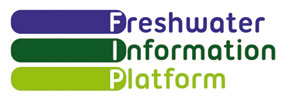


%20Evolution%20of%20greenhouse%20gas%20emissions%20by%20sector_E28_fig25.png)
